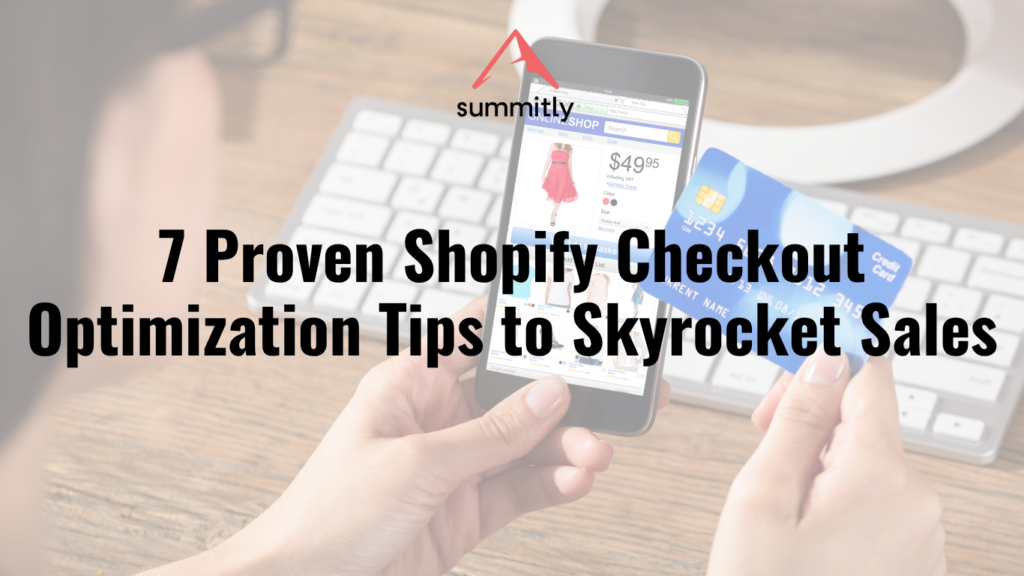
Shopify checkout optimization is critical for boosting conversions and reducing cart abandonment. A seamless checkout process ensures customers complete their purchases, directly impacting your store’s revenue. This article explores seven powerful strategies to optimize your Shopify checkout, helping you create a frictionless experience that drives sales.
Why Shopify Checkout Optimization Matters
A poorly designed Shopify checkout can frustrate customers, leading to abandoned carts. According to Baymard Institute, the average cart abandonment rate is around 69.8%. Optimizing your Shopify checkout reduces friction, builds trust, and increases conversions. Let’s dive into the top tips to enhance your Shopify checkout experience.
1. Simplify the Shopify Checkout Process
A complex checkout process drives customers away. Streamline your Shopify checkout by minimizing the number of steps required to complete a purchase. Remove unnecessary fields in forms, such as asking for a phone number if it’s not essential.
Use Shopify’s built-in features to enable one-page checkouts. This reduces the time customers spend navigating multiple pages. For inspiration, check out Shopify’s guide on checkout customization, which offers practical steps to simplify the process.
Pro Tip: Use autofill features to pre-populate customer information, making the Shopify checkout faster.
2. Enable Guest Checkout for Faster Purchases
Forcing customers to create an account can deter them from completing their purchase. Enable guest checkout in your Shopify checkout settings to allow users to buy without registering. This reduces friction, especially for first-time buyers.
Shopify data shows that stores offering guest checkout see higher conversion rates. Learn how to set this up in Shopify’s help center.
Internal Link: Want to boost trust during checkout? Read our guide on building customer trust in e-commerce.
3. Optimize for Mobile Users
With over 50% of e-commerce traffic coming from mobile devices, your Shopify checkout must be mobile-friendly. Ensure buttons are large enough to tap, text is readable, and forms are easy to fill out on smaller screens.
Shopify’s responsive themes, like Dawn, are designed for mobile optimization. Test your checkout on various devices to ensure a smooth experience. For mobile optimization tips, refer to Google’s Mobile-Friendly Test.
Pro Tip: Enable Apple Pay or Google Pay for faster mobile checkouts, as these options streamline the payment process.
4. Add Trust Signals to Build Confidence
Customers hesitate to share personal information if they don’t trust your store. Add trust signals like SSL certificates, security badges, and customer reviews to your Shopify checkout page. These elements reassure users that their data is safe.
For example, displaying a Norton or McAfee badge can boost confidence. Learn more about trust signals from BigCommerce’s guide on e-commerce trust.
Internal Link: Discover how to enhance your store’s credibility with our Shopify store optimization tips.
5. Offer Multiple Payment Options
Limited payment options can lead to abandoned carts. Expand your Shopify checkout payment methods to include credit cards, PayPal, Apple Pay, and even Buy Now, Pay Later services like Afterpay. Shopify Payments supports a wide range of gateways, making it easy to offer diverse options.
According to Statista, 49% of global shoppers prefer digital wallets. Catering to these preferences can improve your Shopify checkout conversion rates.
Pro Tip: Highlight accepted payment methods early in the checkout process to set clear expectations.
6. Use Exit-Intent Popups to Recover Carts
Exit-intent popups detect when a user is about to leave your Shopify checkout and display a targeted offer, such as a discount or free shipping. Apps like Privy or OptiMonk integrate seamlessly with Shopify to create these popups.
Studies show that exit-intent popups can recover 10-15% of abandoned carts. Configure these popups to trigger only during the checkout process for maximum impact.
Internal Link: Learn more about reducing cart abandonment in our e-commerce conversion guide.
7. Analyze and Test Your Checkout Flow
Continuous improvement is key to a high-converting Shopify checkout. Use Shopify Analytics to track metrics like cart abandonment rates and checkout completion times. Tools like Hotjar can provide heatmaps to identify where users drop off.
Run A/B tests to experiment with different checkout layouts, button colors, or form fields. Shopify Plus users can leverage Shopify Scripts to customize checkout flows dynamically.
Pro Tip: Test one variable at a time to accurately measure its impact on your Shopify checkout performance.Optimizing your Shopify checkout is a game-changer for increasing sales and customer satisfaction. By simplifying the process, enabling guest checkout, optimizing for mobile, adding trust signals, offering multiple payment options, using exit-intent popups, and analyzing performance, you can create a seamless experience that converts. Start implementing these tips today to see a significant boost in your Shopify store’s revenue.
Ready to take your store to the next level? Check out our ultimate Shopify SEO guide for more strategies. Go and visit www.summitly.io